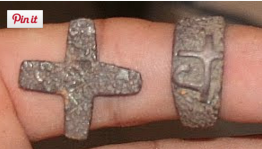Written by the TreasureGuide for the exclusive use of treasurebeachesreport.blogspot.com.
Looks like something out of a comic book.
The maiden voyage of a humanoid robotic diver has gone swimmingly, concluding with the successful recovery of an antique vase from La Lune, King Louis XIV’s flagship, which sank in the Mediterranean in 1664.
The mermaid-like robot, called OceanOne, consists of a five-foot torso, a head with stereoscopic vision and two fully articulated arms. The torso houses the robot’s batteries, computers and eight multi-directional thrusters...
Here are a couple links for more about that.
http://www.engineering.com/DesignerEdge/DesignerEdgeArticles/ArticleID/11957/Humanoid-Robotic-Diver-Recovers-Treasure-from-King-Louis-XIVs-Flagship.aspx
https://news.stanford.edu/2016/04/27/robotic-diver-recovers-treasures/
---
Here is a great web site for learning more about the history of jewelry and mourning and much more. There is a great section on rings, and also a lot of information on symbolism seen in jewelry. There is a lot to be learned from this site and recommend it for anyone interested in learning more about antique jewelry and how it changed during different times in history.
http://artofmourning.com
http://artofmourning.com/category/rings/
http://artofmourning.com/category/other/symbolism/
---
I've been collecting information and have receive emails on the topic of silver rings from the 1715 Fleet. The topic has been very stimulating and has led to a lot of interesting ideas. I'll address the topic in the future from time to time.
---
This was a mystery find at Jamestown. It was found in a cellar.
This cellar, like other cellars in and around the fort, was filled in with trash by the settlers at the end of its useful life as a structure. In a relatively short period of time, the colonists would have filled it with all kinds of garbage and debris, which is why cellars like this one are so rich in artifacts and so interesting to archaeologists who study the material culture and consumption habits of a particular time period.
Below is what it must have looked like when it was new and complete.
This article has several things that I might comment on when I can give it the time.
I've seen old cellars and how they fill in. The top layers have a lot of junk. I know of one that on the top, besides vines and leaves and things like that, had bicycle and car parts. As you get down you get to smaller and older things, some work down to the bottom because they are small and heavy, and some that are simply older.
Here is another paragraph from the article.
Sounds like a familiar question, doesn't it?
Here is part of the answer from the same article.
In the rare event that the grill broke, the colonists may have chosen to repurpose the metal rather than discard the entire grill, which may also account for why this was such a rare find.
That is something we might fail to think of in this "disposable" culture. Years ago things were not thrown away so quickly. They were often repaired or the materials cannibalized and used for some other purpose. There was no Walmart or Home Depot to supply whatever parts or objects were needed.
Here is the link. It provides some good clues for the detectorist.
http://wydaily.com/2016/04/29/local-news-jamestown-unearthed-common-cooking-grill-a-rare-find-for-archaeologists/
---
Saturday we'll have a very small surf along with small tides. I'm waiting for some good negative tides to hit one spot that I've been wanting to hunt for some time.
Happy hunting,
TreasureGuide@comcast.net
































